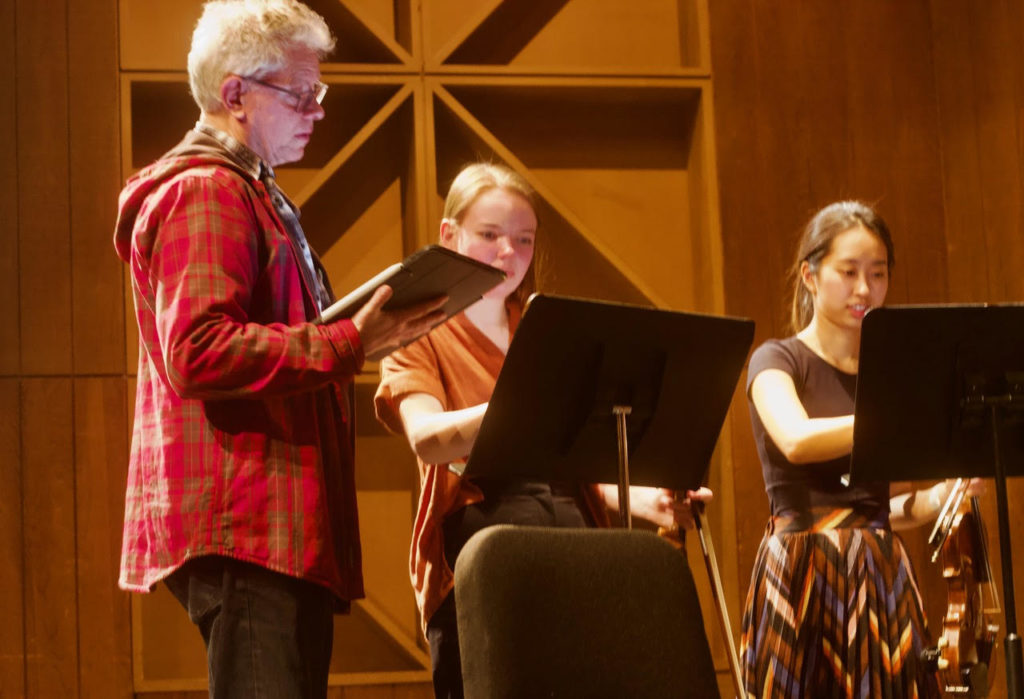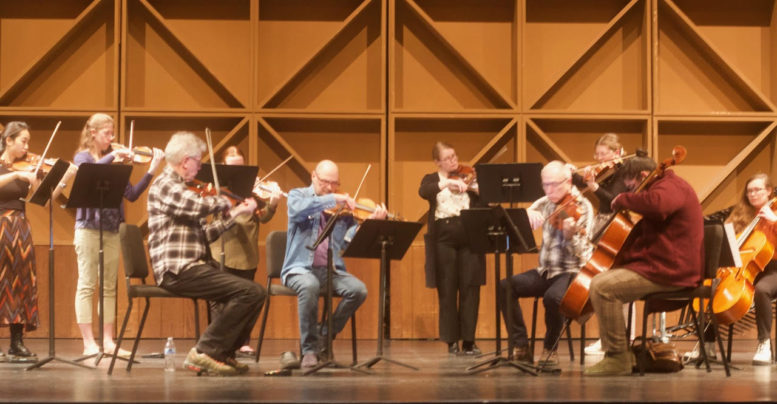By DAVID DUPONT
BG Independent News
The Kronos Quartet had been waiting over 40 years to be invited to play at the Esterhazy Palace in Austria. Composer Franz Joseph Haydn had been employed at the palace for decades in the mid-1700s and it was there he invented the string quartet.
David Harrington, who founded the Kronos Quartet 50 years ago, told a small gathering at BGSU Monday, that the lack of an invitation “was sort of upsetting.” Then the invitation came, and people asked: Are you going to play Haydn?
“Hell, no,” was the response. Kronos was founded in 1973 to perform contemporary music. Instead, they opened their Esterhazy recital with music composed by the American blues artist Geeshie Wiley. This is music that Harrington believes that Haydn and Beethoven and those other early adopters of the string quartet, were they alive today, would love. “My inner Haydn had this big smile on his face,” he said.
When they were invited back, they had the opportunity to teach young string quartets music for the quartet’s “50 for the Future: The Kronos Learning Repertoire.”

Kronos will perform a solo showcasing works in “50 for the Future” tonight (2/14/23) at 8 p.m. in Kobacker Hall in the More Musical Arts Center on the BGSU campus. The public concert, part of the Hansen Musical Arts Series, is free.
The quartet started its residency Monday working with university students and the Perrysburg High School Orchestra.
Through the “50 for the Future” project, the quartet, with a host of partners including BGSU, commissioned 50 works geared toward developing musicians from composers who span the globe and the generations.
This adds to the 900 compositions the Kronos has commissioned since its inception in 1973.
Harrington said that looking back at more than two centuries of string quartets it remains a vital form.
“There’s hardly a composer in the world who does not want to write a string quartet, no matter what continent they’re from, what country they’re from, what culture they’re from,” he said. “Everybody wants to write a string quartet.”
In Africa, Asia, South America, “people are looking at this as a tool to express their inner most musical thoughts.”
The “50 for the Future” project is “a gift to our musical communities,” said violinist John Sherba.
Kronos cellist Paul Wiancko, who is also a composer and contributed music to “50 for the Future,” said he believes the way the voices are spread from the cello up to the violin is the key to its enduring appeal. “It’s ideal for the human ear to hear harmonies, most aesthetically pleasing,” he said.
Wiancko is the only Kronos musician who is not a charter member. He joined this year. But he said, “these three have accepted me into this family instantaneously.”
Hank Dutt, the violist, said that this was still the “honeymoon period.”
Harrington said quartet is a series of conversations, as many as three going on at once. Or four if he’s talking to himself, he quipped.
“There’s an intimacy that’s involved in chamber music,” Sherba said. “You can hear different colors and sounds, even the change in vibrato.”
“When all is said and done,” Dutt said, “it’s fun to go up on stage and communicate with an audience.”
Kronos will share that experience with two student string quartets, the Graduate String Quartet and the Fulton String Quartet, at the concert. The student ensembles will join Kronos at the end of the program to perform “Quartet Satz” by Philip Glass.
Violinists Sujin Kim, of the Fulton Quartet, and Malika Brower, of the Graduate String Quartet, said the rehearsal with Kronos Monday afternoon went well.
Kim said she was impressed not only with how they coached the younger musicians, but how they communicated with each other.
And though they were on stage with musicians they have been listening to and admiring for years, rehearsal was “calming,” Kim said.
They both expressed enthusiasm for the “50 for the Future” program.
Brower said the Graduate Quartet has worked on Missy Mazzoli’s “Enthusiasm Strategies.”
“It’s such a great opportunity for young string players to be able to explore different composers, different cultures,” Brower said.
All the scores, recordings, and teaching guides are available online for free.
“It’s like it was made for my generation,” said violinist Cole Habekost. “We like to get everything for free online.”
Kronos visit gave him a chance to renew his connection with Harrington.
The Kronos founder had a coaching session with Habekost’s string quartet at Maumee Country Day School. The young musician decided he wanted to do his senior project on the quartet and traveled to spend several days with Harrington to observe.
Harrington said he didn’t know Habekost was studying at BGSU until he received an email from the student.
During the question-and-answer session, the group was asked how they stay fresh and invigorated on the road. Harrington said that earlier in the day, he’d given Habekost a lesson. “That’s great,” he said. “I’m not tired at all. I get to hear Cole play and teach a lesson. I got so much energy out of that.”

